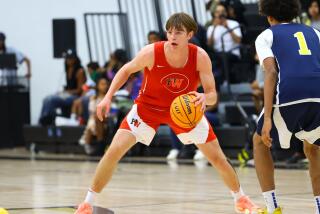RECREATION / BADMINTON : Champ Keeps His Eye on the Birdie : Youthful whiz has whacked his way to a college scholarship in one of the world’s fastest sports.
- Share via
Hoang Ly of Costa Mesa is the reigning Junior National Champion in badminton--arguably the fastest, most physically demanding racquet sport on the planet.
Ly, 19, won his title last June, shortly after he graduated from Estancia High School. His prowess has earned him a full scholarship at Northern Michigan University in Marquette, where he plans to study business administration and computer science.
Though Ly is not yet the best badminton player in the nation, he may be the most talented, according to Martin French, president of the U.S. Badminton Assn.
Think maybe Ly is a bright but physically average kid who lucked into an easy scholarship?
Then you have probably dismissed badminton as “just another feathery back-yard diversion for birdie chasing twerps.”
Consider the following facts:
At the 1992 Olympic Games in Barcelona, badminton will be an official medal sport. Northern Michigan University is the U.S. Olympic Committee’s funded training center for the U.S. badminton team.
As to the sport’s “degree of difficulty,” the August issue of the UC Berkeley Wellness Letter says badminton--played properly--”is a game of perpetual motion, requiring agility, quick reflexes, power and endurance.”
Endurance?
Ly, who also spent two years on Estancia’s cross-country team, says that running 5 kilometers as fast as he can is a piece of cake compared to a best two out of three badminton match. “Rallies between good, evenly matched players seem to last forever,” Ly says.
Power?
“The man who designed the strength-training program for the U.S. Olympic Badminton Team also works for the Denver Broncos,” says Ly’s coach, Paisan Rangsikitpho of Long Beach.
Adds Ly: “I used to win points quickly by slamming all the time, but at this level you can’t do that. Now I usually win points because I’m strong enough to outlast my opponents in long rallies.”
Agility and quick reflexes?
When Ly slams a badminton shuttlecock it travels so fast (more than 100 m.p.h.) that his opponents must leap backwards and twist in the air if they hope to return it. At the same time they must constantly be on their toes for a tapped “drop-shot”--which barely flutters over the net before heading straight for the floor.
By contrast, volleyball players get to jump straight up, or even forward, to spike a large ball that moves in a much narrower speed range. Though the two sports have similar scoring and some common rules, volleyball players merely soar, swoop and dive like eagles, while ever-sweaty badminton players must dart about like hummingbirds.
The Berkeley Wellness Letter concludes that badminton offers an excellent workout for both upper and lower body, that energetic singles players burn about 600 calories per hour (about twice the burn rate of tennis), and that a player in a typical competitive singles match will make abrupt changes in direction more than 200 times and travel more than a mile while running, jumping, twisting and stretching to reach the shuttlecock.
What makes Ly’s scholarship even more impressive is that, except for Arizona State, Northern Michigan is the only college in the country that even offers badminton scholarships. Not one Southern California college has anything more than recreational or club badminton. That’s surprising because, according to Rangsikitpho, an overwhelming majority of the best players in the country live and train in this area.
Ly won first place in the B category in Saturday’s meet at the Manhattan Beach Badminton Club--the most exclusive and prestigious indoor badminton facility in the nation. “The B-C Grand Prix Finals was an invitational championship for the top eight ‘B’ and ‘C’ level players in the country,” Rangsikitpho said. “Hoang was favored to win the B tournament--he has the best speed and power of all the competitors.”
Rangsikitpho describes the $2,000 in total prize money for the meet as “small potatoes” but admits that it is better than no potatoes at all. Still, with the material spoils of victory so small, and the sport’s modest popularity in this country, there is really no such thing as professional badminton--at least not in the multimillion-dollar baseball/basketball/football sense of the word. A small number of serious amateurs and partially sponsored competitors form the tip of badminton’s domestic pyramid while hordes of wheezing back-yard hackers form the base.
In addition to being Ly’s personal coach for the past year and a half, Rangsikitpho, 42, is the president of the Southern California Badminton Assn. and the top ranked senior player (over 40) in the country. He and Ly train together two times a week during the off-season and five times a week between February and April.
Ly, Rangsikitpho and others who love high-energy badminton hope the sport’s Olympic status will help it lose some of its “barbecue sport” image and increase its popularity among physically active people of all ages.
Though the benefits of badminton can be realized on a number of levels both indoors and out, Rangsikitpho urges those who want to reap the physical rewards of the sport to at least learn how to play indoors. “Wind interferes with the flight of the shuttlecock,” he says. Golden West College in Huntington Beach offers a badminton course in its adult program for $40 a semester. Some local recreation departments offer inexpensive lessons, and Bolsa Grande High in Garden Grove--home court of the Orange County Badminton Club--offers free play between 7 and 10 p.m. on Monday and Thursday nights. West Gym on the Cal State Long Beach campus hosts play and lessons between 7 and 10 p.m. on Monday and Tuesday.
For information on the Southern California Badminton Assn., call (818) 343-8816 or send inquiries to P.O. Box 1435, Culver City, Calif. 90232.


